An affordable multiband & multistandard receiver could be the answer to the many different broadcasting standards for analog & digital radio worldwide.
It’s one of our conclusions after talking with 2 radio distribution specialists at IBC 2014 in Amsterdam. How do Swiss antenna designer Ampegon and German transmitter builder Rohde & Schwarz see the future of radio in a technical innovation context? One is a fan of DRM, the other of good-old FM: “The annual equipment replacements alone are a huge potential”.
“There is no question whether
the chicken or the egg came first”

Digital radio adoption depends on great on-air content, broadcast facilitator Ampegon says (photos: Thomas Giger)
Make niche markets big
Ampegon specializes in everything outdoor on a transmitter site, such as antennas for longwave, medium wave and shortwave broadcast, and builds shortwave transmitters. Partner company TRANSRADIO does all things indoor, with transmitters for longwave, medium wave and VLF broadcast. “Together we’re well-positioned in the amplitude-modulated broadcast market”, Ampegon CEO Josef Troxler says. His company leaves out FM, because it’s a mass market with many providers. “We focus on larger projects, rather than large series.” Several state broadcasters and religious groups are clients of Ampegon, which now sees a growing potential in Africa and Asia. Huge continents, with large populations to reach and far distances to cover – using powerful transmitters, and massive antennas made from 200 tons of steel.
 Offer consumers additional value
Offer consumers additional value
Where do you see the trend going in your business; analog or digital?
“It’s clearly going towards digital broadcasting, making data processing more flexible and allowing us to bundle multiple channels, offer better sound, and add extra data. You could include a virtual newspaper, through Journaline for DAB and DRM, without additional cost.” Ampegon expects a future for Digital Radio Mondiale in certain markets.
Collaborate with radio manufacturers
With $120 and $150, DRM receivers are expensive for developing countries where people might be able to afford $20 to $50, and not many stations are broadcasting in this standard yet. “Nobody buys a receiver when there’s no content, so there is no question whether the chicken or the egg came first. Broadcasters have to take the lead. Some have spent millions on transmitters, but didn’t get a consumer electronics company on board. It’s possible by pre-ordering receivers, but this investment on the receiver-side hasn’t happened so far.” Troxler sees India and South Africa as growth markets for DRM.
“It only depends on the receiver”

The ideal digital radio is a combined multiband & multistandard receiver for an affordable price (photo: Tivoli Audio)
Advertise on analog stations
Isn’t this THE challenge for digital radio? The ability to be received by the audience?
“Yes. We see a ray of light in South Africa, where customers acknowledge that the reception problem is a big one.” He says that several stations are interested to order “a few thousand” digital receivers, parallel to building digital transmitters. “That approach should’ve been used from the introduction of digital radio in the first place. Traditional broadcasters can use their analog channels to promote digital technology, and get people to buy a digital receiver. RTL Group wanted to jump on DRM in 2004, and hand out affordable receivers. Unfortunately, they were too early, as the reception technology of DRM wasn’t perfect yet. After 2 years, RTL lost its patience and quit.”
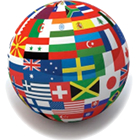 Use worldwide technology standards
Use worldwide technology standards
Josef Troxler expects that Europe will make progress. “The EBU is developing reference models and motivating manufacturers to make microchips suitable for multiple standards. Both DAB and DRM are based on Coded OFDM. In terms of software, it’s easy to combine one open-source technology with the other.” He adds that it may take longer to get the US (with Ibiquity’s proprietary IBOC standard for HD Radio) on board.
Combine multiple bands & standards
It would be great to select a station based on name and description, so you no longer have to choose the frequency band or broadcast standard first…
“That’s exactly what chip manufacturers should offer today. Digital technologies make it possible to build a multiband receiver that is also a multistandard receiver. DAB and DRM allow broadcasters to program an audio stream so that its metadata are constantly updated through an always ‘online’ receiver. You could then make a seamless transition between medium wave and shortwave. In large countries, listeners may receive a station on AM in a city, and on shortwave in the country. All technologies are available. It only depends on the receiver; on having an affordable device.”
“It delivered more energy
than all transmitters there need”
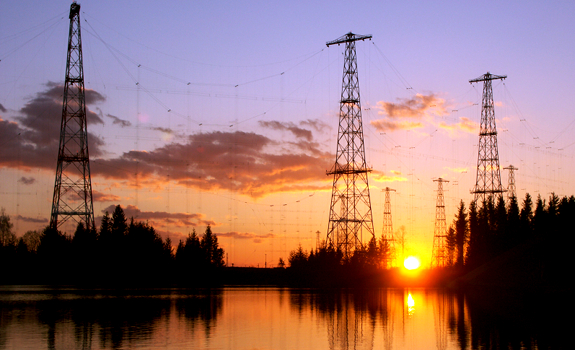
Transmitter sites with photovoltaic technology may run completely on solar energy (photo: Wikipedia / Midnightfun)
(Pre)order many digital radios
Have you thought of building your own receivers, if others don’t do it?
“That’s always a question of investments, haha. As part of a consortium and as an independent company, we’ve tried to collect bulk orders for a couple of thousand digital receivers. We did think of building our own receivers. Within a large project, it might even be worthwhile, now that microchips are affordable. It could be the way forward. We would probably not build them in-house; we would buy them in. With an order of 10.000 or 50.000 receivers, it’s possible to get a price under $100. It’s just a matter of numbers.” Troxler is happy that some smaller Chinese, Indian and South African manufacturers are now standby with working prototypes for cheap-priced digital radios.
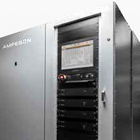 Buy updateable radio transmitters
Buy updateable radio transmitters
Not only radio receivers, but also transmitters are becoming software-based. “With a modern transmitter and digital technology, a standard update is only a question of software. So as a radio operator, you now have more flexibility to upgrade your equipment.” Ampegon sees a trend towards transmitters based on a hardware platform that is completely controlled by software, which can then be upgraded to a new version.
Broadcast on green energy
What’s a current ballpark figure for operating a radio station in your client segment?
“If you need several antennas to broadcast in different directions, and if you want backup transmitters for redundancy, the investment can be anywhere between 10 and 20 million dollars. With good maintenance, most antennas and transmitters can work perfectly for decades, but the electricity bill for a transmitter might be half a million dollars a year.” He explains that green energy is a good way to save budget and nature. A BBC World Service station on Ascension Island is using wind energy apart from diesel generators, and Ampegon has built a 20-megawatt photovoltaic solar installation for a huge transmitter site in Wertachtal, Germany. “It delivered more energy than all transmitters there need.” Digital transmitters are said to save “a third” of the power necessary for analog broadcasting. “Amplitude modulation needs a carrier to transport audio. An analog 500 kW transmitter with a 50 kW signal, would use 90% of your energy for the carrier. Digital radio broadcasting combines both carrier and signal; it’s extremely efficient.”
“Instead of three transmitter racks,
you now need one”
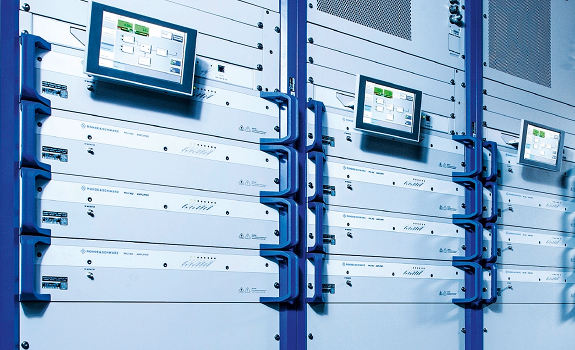
Liquid cooling and centralized redundancy may increase broadcasting efficiency & costs (photo: Rohde & Schwarz)
Attract more young listeners
How do you see the future of radio broadcasting worldwide between 2014 and 2024?
“I’m optimistic. I believe that radio remains to play a very important role. In many countries, people listen to radio for over 3 hours a day – but we have to find ways to reach a young audience. My sons don’t listen to radio anymore; they find their music and information somewhere else. It seems essential to enable radio listening on mobile phones for free. It makes no sense to pay for radio streaming on a mobile, if it’s freely available on FM. In an increasingly divergent broadcast market with many distribution channels, we should preserve the radio niche to stay competitive across all these platforms.”
 Cool transmitters more efficiently
Cool transmitters more efficiently
From Swiss precision to German thoroughness. Cornelius Heinemann (left) is Director of Terrestrial Transmitter Systems at Rohde & Schwarz. Their newest FM transmitter allows clients to use liquid cooling. The benefit is that water (mixed with an anti-corrosive) has a higher density than air, thus extracting “about twice as much” heat from the transistors as air would do. It doesn’t make a difference for a 500 Watt station, but it does for a 50 kW broadcaster.
Combine transmitter backup systems
“Instead of three transmitter racks, you now need one. With air conditioning, the air also needs to go somewhere.” He explains that to generate a 15 kW signal with an air-cooled device, you might need 25 kW of power (due to of 10 kW of heat loss). “In a warm country, you will need a giant air conditioning. ‘How can we help customers to save costs?’ is our main question when developing transmitters. Older models have an efficiency of 50-60%, while newer ones are at 70-75%.” Backup systems can be made more efficient as well, especially for clients like Bayrischer Rundfunk who operate 5 main stations: “They connect several transmitters to one redundancy system. Instead of 5 backup transmitters, they need 1 extra transmitter that could take over when one fails.”
“There could be a large potential,
but I don’t see it right now”
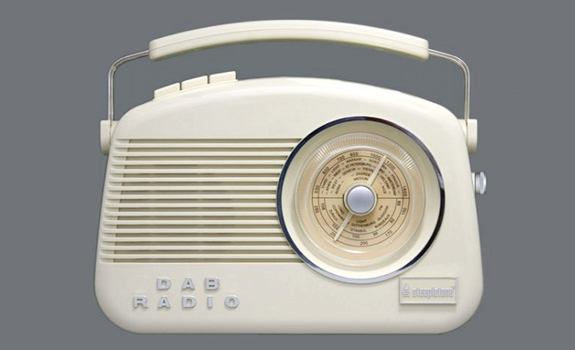
As FM is very established and (in some markets) still growing, digital radio is moving slowly (photo: Steepletone)
Build a motivated team
DAB is already pretty established in the UK and some Scandinavian countries, but the rest of Europe is following with baby steps. Are your customers are interested and willing to invest in digital radio?
“Yes. Norway is a real forerunner. They’ve decided to switch off FM in a couple of years, and to massively invest in DAB.” Heinemann sees other countries being careful, also because of a ‘high investment / low benefit’ perception on the consumer side. “In your car and kitchen, a radio with an antenna is still the easiest thing to have, but it shouldn’t cost much. Digital car radios are still high-priced. Just on the side: Rode & Schwarz hired me to become their DAB expert, back in 1991. I’ve developed our first DAB modulator, so I have a passion for it. I’m always happy when a DAB network is being upgraded with more energy-efficient equipment.”
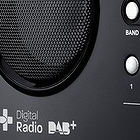 Deliver perfect input signals
Deliver perfect input signals
By the way, can a transmitter influence a station’s on-air sound?
“Interestingly enough, analog transmitters do, but digital transmitters don’t – they either work and replicate the exact sound you put in, or make a coding or modulation mistake and become silent. When you walk through your house with a DAB radio, 1 meter can make a difference between perfect quality and no sound. An analog radio would go from stereo to noise to mono.”
Experiment with various technologies
In your opinion, what are interesting evolving markets and technologies right now?
“Basically, all markets where digital roll-outs hasn’t happened yet – which is mainly TV. The digital roll-out in radio is going slow. In regions like India, investments in FM are even increasing, although they also invest in DRM. In-band-on-channel technology like HD Radio wouldn’t be possible in Europe, where the FM-bandwidth is smaller.” Cornelius Heinemann is happy with recent DAB initiatives in European countries, but he’s convinced that worldwide, FM is here to stay for many years. “It’s so big and very established; the annual equipment replacements alone are a huge potential. That the whole world will move to DAB is something that I’m dreaming of, but I can’t write that in any business plan. There could be a large potential, but I don’t see it right now. FM is very efficient for in-car listening.”
“We cannot assume
that everyone has a flat rate”
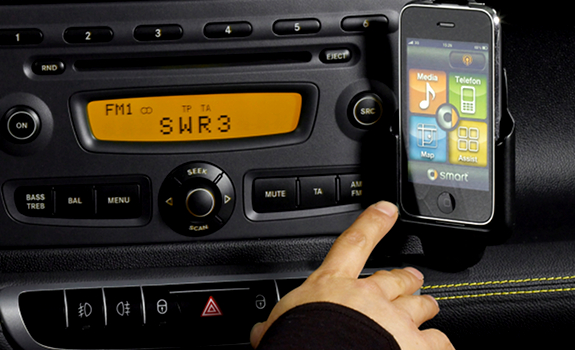
It will take a while before we continuously listen online radio in our car through cell phones (photo: Car & Driver Blog)
Solve distance & cost issues
What do you think of the connected car, where radio is integrated in a larger dashboard?
Rohde & Schwarz VP of Marketing & Technical Sales, Stephan Krafft, shares a story: “I know a colleague who had a car crash with his BMW. Luckily, nothing happened to him, but his car got severely damaged, so the airbag was being activated. That exact same second, his car dealer and the police were automatically alarmed, and received his GPS coordinates. They were there in 5 minutes, hahaha.” Heinemann adds that consumers will always ask if it’s worth the extra cost. “We cannot assume that everyone has a flat rate to continuously listen to online radio. These amounts of data might also shut down everyone’s streaming capacity. If we could make it possible to listen to a station non-stop on a 600-mile drive while it doesn’t cost a fortune, then it’s cool. But I don’t see that happen anytime soon.”





Add Your Comment